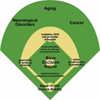Base excision repair: a critical player in many games
- PMID: 24780558
- PMCID: PMC4100245
- DOI: 10.1016/j.dnarep.2014.03.030
Base excision repair: a critical player in many games
Abstract
This perspective reviews the many dimensions of base excision repair from a 10,000 foot vantage point and provides one person's view on where the field is headed. Enzyme function is considered under the lens of X-ray diffraction and single molecule studies. Base excision repair in chromatin and telomeres, regulation of expression and the role of posttranslational modifications are also discussed in the context of enzyme activities, cellular localization and interacting partners. The specialized roles that base excision repair play in transcriptional activation by active demethylation and targeted oxidation as well as how base excision repair functions in the immune processes of somatic hypermutation and class switch recombination and its possible involvement in retroviral infection are also discussed. Finally the complexities of oxidative damage and its repair and its link to neurodegenerative disorders, as well as the role of base excision repair as a tumor suppressor are examined in the context of damage, repair and aging. By outlining the many base excision repair-related mysteries that have yet to be unraveled, hopefully this perspective will stimulate further interest in the field.
Keywords: AP endonuclease; Aging; BER and transcriptional regulation; BER crosspathways; BER in the immune system; BER subpathways; Base excision repair; Cancer; DNA glycosylase search; DNA glycosylases; Neurodegenerative diseases; Repair enzyme structures; Repair in chromatin; Repair in telomeres.
Copyright © 2014 Elsevier B.V. All rights reserved.
Conflict of interest statement
Conflict of interest statement
There is no conflict of interest.
Figures

References
-
- Duclos S, Doublie S, Wallace SS. Consequences and repair of oxidative DNA damage. In: Greim H, Albertini JJ, editors. Issues in Toxicology: The Cellular Response to the Genotoxic Insult: The Question of Threshold for Genotoxic Carconogens. London: The Royal Society of Chemistry; 2012. pp. 109–152.
Publication types
MeSH terms
Substances
Grants and funding
LinkOut - more resources
Full Text Sources
Other Literature Sources
Medical

